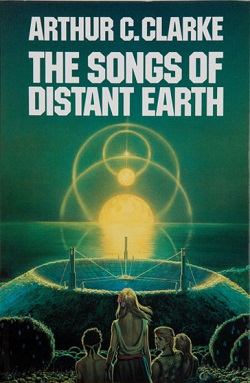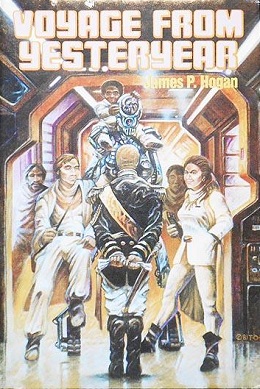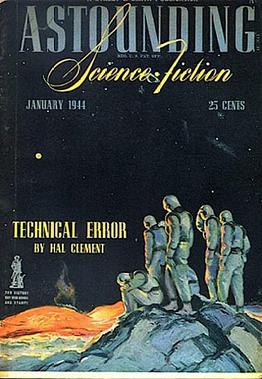Related Research Articles
Enterprise or USS Enterprise is the name of several fictional spacecraft, some of which are the main craft and setting for various television series and films in the Star Trek science fiction franchise. The most notable were Captain James T. Kirk's USS Enterprise (NCC-1701) from the original 1960s television series, and Captain Jean-Luc Picard's USS Enterprise (NCC-1701-D) from Star Trek: The Next Generation.

The Starlost is a Canadian-produced science fiction television series created by writer Harlan Ellison and broadcast in 1973 on CTV in Canada and syndicated to local stations in the United States. The show's setting is a huge generational colony spacecraft called Earthship Ark, which has gone off course. Many of the descendants of the original crew and colonists are unaware, however, that they are aboard a ship. The series experienced a number of production difficulties, and Ellison broke with the project before the airing of its first episode.
Orphans of the Sky is a science fiction novel by American writer Robert A. Heinlein, consisting of two parts: "Universe" and its sequel, "Common Sense". The two novellas were first published together in book form in 1963. "Universe" was also published separately in 1951 as a 10¢ Dell paperback. The work presents one of the earliest fictional depictions of a generation ship.

A generation ship, or generation starship, is a hypothetical type of interstellar ark starship that travels at sub-light speed. Since such a ship might require hundreds to thousands of years to reach nearby stars, the original occupants of a generation ship would grow old and die, leaving their descendants to continue traveling.
A sleeper ship is a hypothetical type of crewed spacecraft, or starship in which most or all of the crew spend the journey in some form of hibernation or suspended animation. The only known technology that allows long-term suspended animation of humans is the freezing of early-stage human embryos through embryo cryopreservation, which is behind the concept of embryo space colonization.
Damien Francis Broderick is an Australian science fiction and popular science writer and editor of some 74 books. His science fiction novel The Dreaming Dragons (1980) introduced the trope of the generation time machine, his The Judas Mandala (1982) contains the first appearance of the term "virtual reality" in science fiction, and his 1997 popular science book The Spike was the first to investigate the technological singularity in detail.

The Songs of Distant Earth is a 1986 science fiction novel by British writer Arthur C. Clarke, based upon his 1958 short story of the same title. He stated that it was his favourite of all his novels. Clarke also wrote a short step outline with the same title, published in Omni magazine and anthologized in The Sentinel in 1983.

Voyage from Yesteryear is a 1982 science fiction novel by British writer James P. Hogan.
"For the World is Hollow and I Have Touched the Sky" is the eighth episode of the third season of the American science fiction television series Star Trek. Written by Rik Vollaerts and directed by Tony Leader, it was first broadcast on November 8, 1968.

In science fiction, hyperspace is a concept relating to higher dimensions as well as parallel universes and a faster-than-light (FTL) method of interstellar travel. Its use in science fiction originated in the magazine Amazing Stories Quarterly in 1931 and within several decades it became one of the most popular tropes of science fiction, popularized by its use in the works of authors such as Isaac Asimov and E. C. Tubb, and media franchises such as Star Wars.

Neil Ronald Jones was an American writer who worked for the state of New York. Not prolific, and little remembered today, Jones was ground-breaking in science fiction. His first story, "The Death's Head Meteor", was published in Air Wonder Stories in 1930, possibly recording the first use of "astronaut" in fiction. He also pioneered cyborg and robotic characters, and is credited with inspiring the modern idea of cryonics. Most of his stories fit into a "future history" like that of Robert A. Heinlein or Cordwainer Smith, well before either of them used this convention in their fiction.
The planetary systems of stars other than the Sun and the Solar System are a staple element in many works of the science fiction genre.

The Wizard of Linn is a science fiction novel by Canadian American writer A. E. van Vogt, a sequel to Empire of the Atom. The novel was originally serialized in the science fiction magazine Astounding Science Fiction. It was first published in book form in Germany in 1961 by Terra Sonderband, as Der Zauberer von Linn.

Galactic Derelict is a science fiction novel by American writer Andre Norton, the second in her Time Traders series. It was first published in 1959, and as of 2012, had been reprinted in eight editions. It is part of Norton's Forerunner universe.
The following outline is provided as an overview of and topical guide to Star Trek:
Star Trek: Planet of the Titans, also known as Star Trek: Planet of Titans, is an unproduced film based on Star Trek, which reached the script and design phases of pre-production. Following the success of Star Trek in broadcast syndication during the early 1970s and the popularity of the series at science-fiction conventions, Paramount Studios made several attempts to produce a feature film based upon the series. In 1975, Star Trek: The God Thing was proposed by franchise creator Gene Roddenberry but was not picked up by the studio.

Aurora is a 2015 novel by American science fiction author Kim Stanley Robinson. The novel concerns a generation ship built in the style of a Stanford torus traveling to Tau Ceti in order to begin a human colony. The novel's primary narrating voice is the starship's artificial intelligence. The novel was well-received by critics.

Far Centaurus is a science fiction short story by Canadian-American writer A. E. van Vogt, first published in Astounding Science Fiction in 1944. Writer and critic P. Schuyler Miller called it "unforgettable and unforgotten."

Space travel, or space flight is a classic science-fiction theme that has captivated the public and is almost archetypal for science fiction. Space travel, interplanetary or interstellar, is usually performed in space ships, and spacecraft propulsion in various works ranges from the scientifically plausible to the totally fictitious.
References
Citations
- ↑ Wilcox 1940.
- ↑ Caroti 2009, p. v.
- ↑ Caroti 2009, p. 13.
- ↑ Bone 2014.
- ↑ Caroti 2009, p. 14.
- ↑ Ash, Brian (1977). The Visual Encyclopedia of Science Fiction. Harmony Books. ISBN 978-0-517-53174-7.
- ↑ Walwyn 2015.
Bibliography
- Wilcox, Don (April 1940). "The Voyage That Lasted 600 Years". Amazing Stories. pp. 82–104.
- Bone, Jesse Franklin (May 2014). Science Fiction Gems, Volume Seven, Jack Vance and others. Armchair Fiction & Music. ISBN 9781612872070.
- Walwyn, Isaac (27 August 2015). "Far Centaurus". Sevagram.
- Caroti, Simone (August 2009). "The generation starship in science fiction, 1934-1977". Purdue University. ProQuest 304990634.